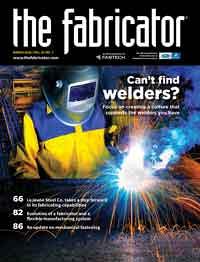Senior Editor
- FMA
- The Fabricator
- FABTECH
- Canadian Metalworking
Categories
- Additive Manufacturing
- Aluminum Welding
- Arc Welding
- Assembly and Joining
- Automation and Robotics
- Bending and Forming
- Consumables
- Cutting and Weld Prep
- Electric Vehicles
- En Español
- Finishing
- Hydroforming
- Laser Cutting
- Laser Welding
- Machining
- Manufacturing Software
- Materials Handling
- Metals/Materials
- Oxyfuel Cutting
- Plasma Cutting
- Power Tools
- Punching and Other Holemaking
- Roll Forming
- Safety
- Sawing
- Shearing
- Shop Management
- Testing and Measuring
- Tube and Pipe Fabrication
- Tube and Pipe Production
- Waterjet Cutting
Industry Directory
Webcasts
Podcasts
FAB 40
Advertise
Subscribe
Account Login
Search
Smart analytics for the metals buyer
Fine-tuning a metal fabricator’s materials purchasing, with data
- By Tim Heston
- March 6, 2020
- Article
- Metals/Materials

Advances in data analytics reveal that there’s more to materials purchasing than the price per ton of metal. Getty Images
If risk managers were to look at a metal fabricator’s financial statements, they would find one cost that stands apart. It wouldn’t be the labor cost, which is what everyone thinks about when a factory moves to another region of the country, continent, or world. They instead would notice another number that, at least at some operations, can dwarf all the others: direct materials costs.
The latest “Financial Ratios & Operational Benchmarking Survey,” published by the Fabricators & Manufacturers Association International, reported an average direct material cost of 33% of sales. That’s more than double the average for an operation’s total labor costs, both direct and indirect.
The wildly fluctuating costs of raw material over the past several years have introduced additional wrinkles into the risk equation. Considering the materials pricing tumult of recent years, and the fact that material often represents a fabricator’s largest cost, one would think manufacturers have sophisticated tools to manage the risk and optimize materials purchasing choices.
“Some manufacturers do in fact have some sophisticated home-grown tools that they use. But more often than not, you’ll see materials buyers working off of Excel templates.”
So said Donald Bly, New York-based managing director of Applied Value, an investment and management consulting firm that works with a number of small and large steel buyers, including several automotive OEMs.
“We’ve built all sorts of Excel-based tools and templates for our consulting clients, and in doing so, a lightbulb went off in our heads,” he said. “We felt it all could be part of a much more structured, SaaS [software as a service], web-based platform.”
Smart analytics has been part of manufacturing for years, though it’s been largely absent from the purchasing function, particularly when it comes to analyzing the details of specific grades. According to Bly, Applied Value is hoping to change this.
At this writing the company is in the final stages of developing a SaaS platform called Sourcing Value, designed for OEMs as well as fabricators in the materials-buying supply chain. The company hopes to open it up for testing soon and then roll out the full release by the end of the year.
Sourcing Value’s goal is to build a data analytics platform that accounts not just for price, but instead total cost of ownership of a specific material grade purchased to certain specifications, including dimensions, thicknesses, chemistries, coatings, and tolerances. As many fabricators are all too aware of, a bad material purchase can wreak havoc on shop floor operations, effectively making cheap material not so cheap after all. Even high-quality material can cause manufacturing costs to spiral if its specifications aren’t well-matched to the application.
Bly added that the platform uses published material specifications from a company’s list of qualified suppliers, but users might want to incorporate operation-specific idiosyncrasies. Thanks to tolerance windows and the nature of steelmaking, two identically specified material grades from two different suppliers (or even two different heats from the same supplier) might cut differently on the laser or bend differently on the press brake. Even so, incorporating detailed material specs into the purchasing equation from the get-go at least puts a fabricator at a good starting point.
Then comes the supply chain optimization. Who in the supply chain should buy and own the material, when, how much, how often, and for which orders? What are the processing steps throughout the supply chain, at service centers, fabricators, and OEMs? What are the freight routes and delivery timetables?
“You now have materials transactions throughout the value chain,” Bly said. “You’ve got managed- and directed-buy type programs, resale programs, and others. Many large OEMs have smaller fabricators participate in these programs. We want to be able to account for and track these programs on both sides of the equation, at the OEM as well as at the fabricator.”
Next come pricing dynamics that use a matrix that builds off of existing intelligence on several dozen material specifications tailored for the job, factoring in the effects of fluctuating market conditions. “Each one of these material specifications or attributes correlates to a cost structure,” Bly said. “If you use grade X versus grade Y, it gives you a cost delta. If you buy dimension X versus dimension Y, it will give you a cost delta for that.”
For OEMs and others that design their own products, such pricing data could be incorporated into design decisions. As Bly explained, “When we understand the material specifications and pricing dynamics as it relates to those specifications, then we can start playing the what-if game. ‘If we change this, how does this affect our cost, both in terms of cost per ton of material and the waste [like the amount of scrap]?’”
The platform then can benchmark against similar organizations. Bly said that Applied Value already has a large database of purchasing benchmarks. But when the Sourcing Value platform is rolled out, the benchmarking data will grow over time.
Bly clarified that Applied Value isn’t building the platform as a crystal ball. No foolproof material-pricing predictor exists. The aim, he said, is to introduce smart data analytics to the world of materials purchasing. After all, as a job function, materials purchasing shouldn’t be separate but instead intertwined with sales, engineering, estimating, and manufacturing, within companies and even up and down the supply chain. It sounds obvious, but metal fabrication starts with, well, the metal.
About the Author

Tim Heston
2135 Point Blvd
Elgin, IL 60123
815-381-1314
Tim Heston, The Fabricator's senior editor, has covered the metal fabrication industry since 1998, starting his career at the American Welding Society's Welding Journal. Since then he has covered the full range of metal fabrication processes, from stamping, bending, and cutting to grinding and polishing. He joined The Fabricator's staff in October 2007.
subscribe now

The Fabricator is North America's leading magazine for the metal forming and fabricating industry. The magazine delivers the news, technical articles, and case histories that enable fabricators to do their jobs more efficiently. The Fabricator has served the industry since 1970.
start your free subscription- Stay connected from anywhere

Easily access valuable industry resources now with full access to the digital edition of The Fabricator.

Easily access valuable industry resources now with full access to the digital edition of The Welder.

Easily access valuable industry resources now with full access to the digital edition of The Tube and Pipe Journal.
- Podcasting
- Podcast:
- The Fabricator Podcast
- Published:
- 04/16/2024
- Running Time:
- 63:29
In this episode of The Fabricator Podcast, Caleb Chamberlain, co-founder and CEO of OSH Cut, discusses his company’s...
- Industry Events
16th Annual Safety Conference
- April 30 - May 1, 2024
- Elgin,
Pipe and Tube Conference
- May 21 - 22, 2024
- Omaha, NE
World-Class Roll Forming Workshop
- June 5 - 6, 2024
- Louisville, KY
Advanced Laser Application Workshop
- June 25 - 27, 2024
- Novi, MI































